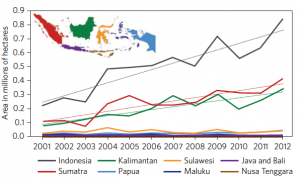
Using Landsat satellite data, the researchers looked at deforest trends occurring on the archipelago nation between 2000 and 2012, and found that over 6 million hectares (close to 15 million acres) of old-growth, or “primary” forest were lost over those dozen years. They also discovered that the pace of the old-growth clearing increased by 47,600 hectares per year (~117,600 acres) and that by 2012, the last year of the study, Indonesia had outpaced Brazil in loss of old-growth forests.
The loss of Indonesia’s old-growth forests has major implications for both carbon emissions and biodiversity.
Old-growth forests are the world’s largest above-ground stores of carbon, and peatlands the world’s largest soil stores. Recently in Indonesia, lowland and wetland old-growth forests have borne the brunt of clearing. Clearing of the wetland old-growth forests—which grow in peatlands—release massive amounts of carbon. The high rate of clearing, especially of these wetland forests, have made Indonesia the world’s third largest emitter of carbon dioxide. Old-growth forest clearing dynamics have major implications to greenhouse gas accounting efforts, and need to be well understood.
Thanks in large part to its old-growth forests, Indonesia is considered a mega-diverse country, with a staggering level of biodiversity. The country’s forests contain 17% of the world’s bird species, 16% of the world’s reptile-amphibians, 12% of the world’s mammals, and 10% of the world’s plants.
Old-growth forests provide a singular habitat for these species. Replacing old-growth forests with commercially managed forests, such as oil palm estates can have major implications for biodiversity richness and conservation efforts.
Incredibly, this study found that of old-growth forest cleared within national forest lands, nearly 40% was cleared in areas that are supposed to restrict or limit forest clearing—included 16% in protected forests and preserves.
Indonesia implemented a deforestation moratorium in May 2011, but since then the country has experienced its highest level of old-growth forest loss—it seems the clearing moratorium caused a clearing frenzy.
Reference:
+ How the Indonesian government is fighting forest fires & haze

Scenes from the Polar Night
Landsat satellites have begun regularly acquiring images of ice at the poles during the winter, with enlightening results.





